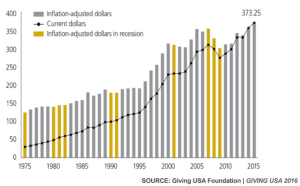Marc A. Pitman's Blog, page 27
July 7, 2016
Your fundraising letters helped by zombies
Have you ever struggled with the active voice vs. passive voice in your fundraising letters?
It's so easy to slip into the passive voice, thinking it sounds more "objective" or "business-like."
But active voice is easier to read and is better at accomplishing your goal: getting donors to take action!
While it's best to have two or three others read the fundraising letter before you send it, sometimes those people miss things too.
A handy way zombies can help your fundraising lettersI just ran across this handy test on Pinterest.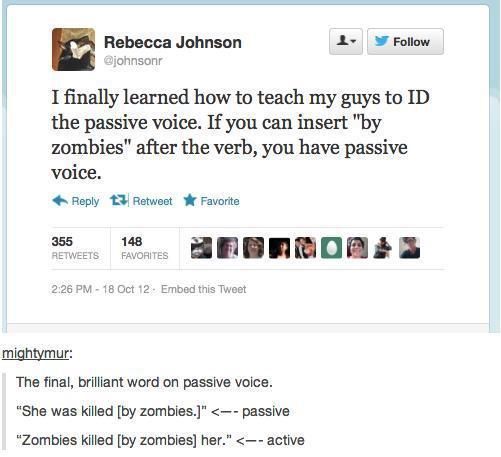
Quite funny, isn't it? But it's true!
Use this test the next time you write a fundraising letter and let me know how it works! 
June 23, 2016
Telling Stories that Move Donors to Give
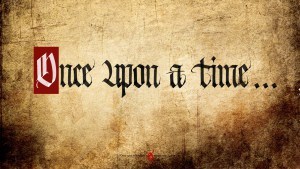 It was the midst of the Great Recession, and about one in ten people across the U.S. were out of work. Amadou was one of them.
It was the midst of the Great Recession, and about one in ten people across the U.S. were out of work. Amadou was one of them.
Unemployment benefits helped his family, for a while. But he had worked for a low wage, and his benefits were only a fraction of that—and then they ran out.
The only thing keeping Amadou, his family, and lot of families in Somerville, Massachusetts from starving was the SNAP program—what we all call “food stamps.”
I knew Amadou. And I knew the anti-poverty agency where I worked was signing people up for food stamps...and saving lives. But how could I show that to our donors?
Should I tell them that the agency helped 300 families get food stamps in one year? Most of our donors would have no way to tell if that was a big number or a small one, for the low-income people in our city.
Should I tell them how our agency convinced the food stamp bureaucracy to accept applications right there in our office? Because of us, Somerville families didn’t have to take a bus to a train to another train to apply for food stamps, spending hours getting there and back. But how much would that mean to the person who doesn’t use SNAP?
Here’s what I did instead. I asked Amadou to tell his story.First, he told the story of a hard-working immigrant trying to make a better life for himself and his family to the community newspaper. They published it with a photo of his family, at home, putting a face on the words “food stamps.”
Then, the agency used Amadou’s story in our own communications: in our print newsletter, on our website, on our Facebook page.
Finally, we included it in a fundraising appeal. We told our donors that because they supported our efforts, Amadou and his family (and hundreds like them) would make it through the Recession. And our donors responded.Why does storytelling matter?
If you want me to act, you have to touch my heart. Storytelling is the most powerful way to engage the emotions of your donors. As Network for Good tells us,
Donors tend to give twice as much when presented with a story about an affected individual, as opposed to reading huge abstract numbers of the overall scope of a problem.
Storytelling also gives your Board members a way to answer their friends who ask, “What does that group do, anyway?” But it only works if people at your nonprofit organization know how to recognize stories, collect them for future use, and tell them in a captivating way.
What is, and is not, a storyTo recognize a story, think of those tales we heard as children. What made us ask our parents, “Tell me a story”? and then, “Another”?
A story is not just a sequence of events.Try telling a child, “A girl went into a stranger’s house, sat in a chair, and ate some porridge. Then she lay down in a bed and fell asleep. The house belonged to a family of bears. Fortunately, she woke up and ran away. The End.”
Do you think your child will ask for that story again? I don’t either!
Just because something has a beginning, a middle, and an end doesn’t mean it’s a tale that will capture the imagination and move your donors to give.
A story has a narrative structure.As Andy Goodman tells us, “To make sure you cover all of the basics of story structure, here are the beginnings of seven sentences that can help you with the process.”
Once upon a time… (This starts the story off and introduces our protagonist)And every day… (This will set up how life was before the Inciting Incident)Until one day… (This begins the action of the story with the Inciting Incident and the Goal)And because of this… (This introduces the barriers or obstacles the protagonist faces)And because of this… (There could be several barriers)Until finally…(This ends the story with the Resolution)Learn to Recognize and Tell Your StoriesYou can learn more about how to find and tell powerful stories by signing up for a Nonprofit Academy webinar that I’m presenting: Where’s the Story Here? Nonprofit Storytelling for Fun and Profit. You will learn:
What makes a story more than one darn thing after anotherThe types of stories your nonprofit should learn to tellHow to make sure you recognize, collect, and use stories in your donor communicationsWhy you should make the donor the hero of the storySign up for the July 12 webinar today, for a happy ending!
The post Telling Stories that Move Donors to Give appeared first on FundraisingCoach.com.






June 17, 2016
Giving continues to grow
Fundraising in nonprofits can be an almost thankless task. At the end of each fiscal year, no matter how well you did, you start again at zero. It can feel like funds don't come in as quickly as you or your leaders would like. In fact, it's easy to start thinking that people aren't giving. That they're tired.
So it's great to have the researchers at GivingUSA collect real data on giving.
Giving grew 4.1%Image (c) GivingUSA. Used with permission.
GivingUSA is the longest ongoing research on giving in the United States of America. As such, it's helpful to see the trends over years. And in the last year, giving grew by 4/1% to a total of $373.25 billion.Some key points to note:
Individual Giving makes up 80% of all givingAs we make the point in Fundraising 101, individual giving remains at 80% of all giving. If you read the report, individual is 71% and bequests are 9%. Since only individuals can leave bequests, we combine the two for general training and coaching.
Key takeaway: challenge your organization to balance fundraising with facts - what if 80% of your organization's fundraising time were focused on individuals?Per capita giving grows
Not only did giving grow, but last year per capita giving by U.S. adults reached $1,101. The report says that is an average of $2,124 per household.
Key takeaway: People continue to give to things that matter to them. If giving to your organization isn't what you'd like, try changing your communications and storytelling.People continue to be generous
The good news is that people continue to be generous. So don't grow tired of repeating contact with donors and prospects.
For more details, get the report on GivingUSA's site: http://GivingUSA.org.
The post Giving continues to grow appeared first on FundraisingCoach.com.






#FollowUpFriday and piling up fish?
I just sent this out to everyone getting weekly #FollowUpFriday email reminders:
It's #FollowUpFriday!It's Follow Up Friday! Over on the http://followupfriday.org/ page, D.C. Dreger quoted a John Grisham character calling today "fish Friday." D.C. says,
"These are contacts and calls that have been sitting around for a while so, like fish, they are beginning to stink. He sets aside time to make the contacts and calls so his Monday is a fresh start."
What if today you took time to clear your fish pile?
Schedule time to follow up! And let us know what follow up you do today by leaving a comment at http://FollowUpFriday.org/ just like D.C. did. Or by using the hashtag #FollowUpFriday when you post to social media!
Will you commit to clearing the fish pile this #FollowUpFriday?The image of fish piling up and beginning to smell is powerful. Will you allow yourself the gift of a fresh start?
Want a free weekly email reminder like this? Sign up at: http://FollowUpFriday.org/
The post #FollowUpFriday and piling up fish? appeared first on FundraisingCoach.com.






June 3, 2016
One of 2016's top 25 Fundraising Experts
 I'm honored to find myself on the list of America's Top 25 Fundraising Experts.
I'm honored to find myself on the list of America's Top 25 Fundraising Experts.
It's great to be in the company of people like Jerold Panas, Penelope Burk, Tom Ahern, and Simone Joyaux.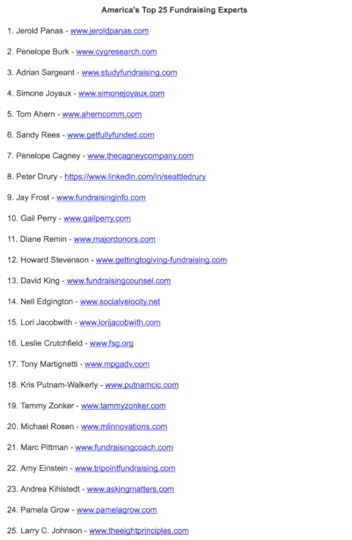
You can see more about the list at:
2016 America's Top 25 Fundraising Experts
The post One of 2016's top 25 Fundraising Experts appeared first on FundraisingCoach.com.






May 30, 2016
Mobile Giving 101
Mobile giving is one of the hottest topics in town.
That being said, many people have been throwing the term around without fully understanding its practices or implications.
It’s more than just texting to give.
And that’s precisely why we’ve crafted this essential guide to mobile giving.
We’ll explore everything from the definition of mobile fundraising to its inherent benefits and beyond.
In fact, let’s not play the guessing game; here’s exactly what we’re going to cover over the next three weeks:
#1. The Definition of Mobile Giving and More!
#2. What’s the Difference between Mobile and Text-to-Give?
#3. The Many, Many Benefits of Mobile Fundraising.
#4. How Do Most Nonprofits Take Advantage of Mobile Giving?
#5. Tips for Getting Started with Your Own Campaign.
#6. How Do You Use Social Media to Boost a Mobile Fundraiser?
Now that you have an idea of the questions we’re planning to answer, let’s go ahead and dive into the answers!
That donation is not added to the donor’s phone bill, but is instead instantaneously processed through a mobile payment processor. It’s just like shopping online--only way more charitable!
In essence, mobile giving is the umbrella term for several different ways to give, and text-to-give is just one of those many ways.
This is Part 1 of 3. Next week, we'll look at:
#3. The Many, Many Benefits of Mobile Fundraising.
#4. How Do Most Nonprofits Take Advantage of Mobile Giving?
To learn even more about mobile giving, get @Pay’s Ultimate Guide to Mobile Giving.
The post Mobile Giving 101 appeared first on FundraisingCoach.com.






May 23, 2016
Is your mission statement trying too hard?
 Can you recite your nonprofit's mission statement? Does it inspire and energize? Or is is more like a laundry list of tasks?
Can you recite your nonprofit's mission statement? Does it inspire and energize? Or is is more like a laundry list of tasks?
If it sounds like tasks, it's hurting your fundraising.
Your nonprofit's mission is vital. It's needed. It should inspire passion. When it does, it can transform your community.
Giving your mission statement a makeoverIn a recent Movie Monday, Lynn Harden, executive director of the Regence Foundation, describes her experience with a small nonprofit women's center helping survivors of domestic violence. The center was struggling with funding, struggling to be heard in their community and, struggling with not enough talent on their board.
They thought they needed more funding. Lynn knew they actually needed vision and a mission statement that the community could get behind. Their mission statement was long and basically a list of what they did:
"The Battered Women's Shelter provides shelter, education, and job opportunities for victims of domestic violence."
She knew domestic violence was an important issue. And she knew that communities felt this was an important issue. But there was nothing that touched the heart in their mission statement. Nothing that would drive people to action. As Lynn describes it there was nothing to get villagers to "taking out the pitchfork and firing up torches to conquer the monster" (like scenes in old Frankenstein movies).
She realized they needed to change their own perception of their work. Together they created a much simpler statement, one much easier to remember.
"Our mission is to protect a woman's right to feel safe in her own home."
They began to write about themselves differently. They began to view their work as a board and as a staff differently.
Amazing things happen when your community understands your missionThe mission statement changed how the community views the organization and about domestic violence. The police department change their procedures about restraining orders. Judges changed sentencing of offenders to better protect survivors. Faith communities came to the table and started providing domestic violence awareness within their communities. The YMCA started an anger management class for men.
The mission statement "resonated so heavily with so many different kinds of people" that the community realized domestic violence actually cut across all socio-economic groups in their community. Better still, the mission statement helped people raise their hands to either say "I need help" or "I can help."
All of a sudden, their board was engaged more effectively because better skill sets were now at the table.
"The power of a mission statement sits in front of and carries an organization forward. It brings out in community a sense in the community of 'we cannot say no to this.'" - Lynn Harden
Their inspiring mission statement solved their funding problems, their board problems, and made a bigger impact in their community than they'd come to expect.
Is it time to revisit your mission statement?Would you like to have that sort of impact? One that inspires a community to rally around it?
One great place to start is by taking out your mission statement and, as a group, asking, "Ok, but why? Why do we do that?"
If you need more inspiration, look over the fundraising appeals that brought in the most gifts. What messages were in them? What were donors getting behind?
We're not talking about changing your mission. Not at all! We are talking about restating how you describe that mission to others. The results can be amazing.
This could be a great discussion topic if you're responsible for a board or staff retreat!
You can watch Lynn describe the results herself at: http://moviemondays.com/112-mission-statement
The post Is your mission statement trying too hard? appeared first on FundraisingCoach.com.






April 27, 2016
One way to avoid a failed capital campaign
Recently, I've been getting a lot of questions about capital campaigns. Some nonprofits are going into them wisely, knowing that they have one-time additional costs to be able to better fulfill their mission. Others are looking at a campaign like a "Hail Mary" pass - a last ditch effort to raise needed funds to operate day-to-day.
The first way of thinking is good; the latter isn't. It reminds me of Albert Einstein's quote: "We can not solve our problems with the same level of thinking that created them."
"We can not solve our problems with the same level of thinking that created them." -Albert Einstein
If you go into a capital campaign with "annual fund" thinking, you'll never be successful.
How to avoid the biggest mistake with a nonprofit capital campaign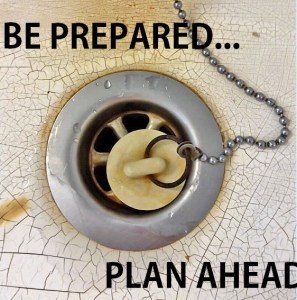 Over a decade ago, I worked with a wonderfully passionate, all-volunteer board of a theater company. They were super excited because they had the opportunity to buy the building they'd been performing plays in for the last 60 years. They building would "only" cost $1...but the renovations to fix the 74 fire violations would cost over $300,000!
Over a decade ago, I worked with a wonderfully passionate, all-volunteer board of a theater company. They were super excited because they had the opportunity to buy the building they'd been performing plays in for the last 60 years. They building would "only" cost $1...but the renovations to fix the 74 fire violations would cost over $300,000!
The board ignored that the people they thanked as "major donors" had only given $300 and $400 dollars a year. More importantly, the board ignored the fact that the building had been looked at and rejected by the best redevelopment organizations in the state. The professionals, people refitting old buildings day in and day out, didn't see this old building as a safe investment. But the volunteer board members thought they knew better. Despite the fact that none of them were architects, builders, or in real estate!
The board was enthusiastic about hiring me to do a planning study. We'd even come to agreement about the details of the project. But just before the vote, I asked them, "If in two months, the report on this planning suggests you'd be better off taking a year or two of building a major gifts program, will you do that? Or will you go ahead with the campaign anyway because this opportunity is so good?"
They all agreed that they'd go ahead with the $300,000 campaign despite the study. The time "was right."
I respectfully suggested they not hire me. I told them a better use of the money they'd already decided to spend would be to engage a PR firm to get their story out now.
They never got their campaign off the ground.Plan your work; work your plan
I see this all the time. Nonprofit leaders get excited about an initiative, a building project, or some other "great opportunity." Forgetting what they know about making money in other areas of their life, they believe that the opportunity is so "self-evident" that everyone will give to it.
Everyone won't.
One of the best ways for a nonprofit to know if people will give is to ask. Those of us who've done dozens of campaigns tend to call this a "planning study" or a "feasibility study." The idea is to interview your best donors and other community influencers following a consistent conversation guide to ensure statistically quantifiable results. We would check to see if this project resonated with them; where the theater landed in their giving priorities; and other aspects that make up a successful capital campaign.
These planning studies can be disheartening. One organization I worked with wanted to raise $14 million but the planning results only indicated the ability to raise $7 million. We didn't want to hear that. But we moved forward with a $7 million project and successfully completed it. This set us up far better for raising a second $7 million than if we'd gone ahead with the full $14 million and still "only" raised $7 million. Not reaching goal can be devastating for nonprofits and the morale of their boards.
Successful capital campaigns have a regular structure, a process, and established pattern. To avoid a failed capital campaign, I'd recommend starting with this type of planning study. Test your assumptions. See if the opportunity really is "self evident" or if the story needs some more work.
If you are considering entering a capital campaign and want to learn more, go to Andrea's training Capital Campaigns 101 (click here: https://thenonprofitacademy.com/vault/capital-campaigns-101/. In about an hour, she gives you the entire overview of how a capital campaign works and what to look for in each phase. You'll have a much better sense of if your nonprofit is ready for the planning study, or has some work to do first.
The post One way to avoid a failed capital campaign appeared first on FundraisingCoach.com.






April 18, 2016
Tips & Tricks from the Foundation Side of Grant Seeking
Grant seeking is a distinct form of fundraising - one that can seem like a complete mystery. That's why I asked Diane H. Leonard to share some tips. She's not only written grants, she's successfully helped others write them. More importantly, she's even worked in a foundation that gave out grants. She has seen it all. And she knows what works. Diane is on Twitter @dianehleonard. She goes into much more detail in The Nonprofit Academy training Tips & Tricks from the Foundation Side of Grant Seeking.

By Diane H. Leonard, GPC
Most grant professionals have a winding story for how they became a “grant writer.” My story started as the Program Office for the Michigan Women’s Foundation. Being a program officer was a HUGE part of my “story” for why I work on the grant seeking side and why I founded DH Leonard Consulting & Grant Writing Services back at the beginning of 2006, but many people don’t know that. The lessons I learned sitting in the chair of a program officer and working with peers in the grant making field from The Kresge Foundation, The Community Foundation of Southeastern Michigan, The Nokomis Foundation and the like have forever shaped my approach to grant seeking.
The lessons I learned defined my approach that nonprofit capacity building and ultimately an organization’s grant readiness is a critical aspect of each and every grant application.
Here are the top lessons I learned that I apply to my grant seeking work on a daily basis to help YOU strengthen your grant seeking.
Four Lessons Learned When I Was a Program OfficerBuilding Relationships Is a Critical Part of Grant Seeking/Grant MakingBuilding relationships is a critical part of grant seeking. The reason I talk so much about the “3 R’s of Grant Seeking” (Research, Relationships and wRiting) is in part because relationships help program officers have a strong sense of the work the foundation grantees are doing and report on the activities to their grant making committees and board members.Do Your Homework
If you are going to reach out to a program officer, do your homework, be prepared for your conversation, phone call, or email dialogue. Be prepared with talking points that ideally include:
A brief introduction of who you are/what group you are with;Why *YOU* think based on your research that your organization/project is a good fit for the foundation’s priorities; andWhat questions you have about the process based on your thorough research of their published materials so that you can be as competitive in their process as possible.Pick Up The PhoneThis could also be called, “don’t hide behind email.” Go old school and pick up the phone.
Now the exception to this is when a foundation or other grant making organization specifically says that phone calls are not welcome. In that case, respect their process and their wishes and follow their allowed communication channels for pre-award conversation if any are available.Ask for Feedback…After Each Proposal Whether Denied or Funded
Whether you receive a grant award or are denied, you should ask the program officer with the foundation for feedback on your proposal.
These will help you get your grant seeking on track. I dig into in more detail in my session for The Nonprofit Academy at http://thenonprofitacademy.com/vault/grant-funding/.
The post Tips & Tricks from the Foundation Side of Grant Seeking appeared first on FundraisingCoach.com.






April 6, 2016
How Small Shops Can Overcome the Challenges of Fundraising Software
Too many nonprofits think that choosing a fundraising software provider is the end of a journey. It's really just the beginning. Using software is essential, but the use you'll get from it is only as good as your data and the training your provide your team. And the tools keep changing, so it's likely that you are trying to work with lots of different types of software! I've asked Blake Groves, VP of Strategy and Business Development at Salsa Labs to share what he sees most helps small nonprofits. With over 20 years in technology, he has seen it all! These four steps, while deceptively simple, will significantly help you in your nonprofit fundraising.How Small Shops Can Overcome the Challenges of Using Different Types of Fundraising Software

by Blake Groves, VP at Salsa Labs
You’ve likely heard the word synergy thrown around in sort of vague terms, slapped onto the end of other words (corporate synergy, anyone?), and universally understood to mean some sort of coming together.
By definition, synergy refers to when different entities join forces to be a greater whole than the sum of their parts. Sound familiar?
Synergy is awesome in theory, but much harder to pull off in practice.
When it comes to attempted synergy, small nonprofits juggling multiple pieces of fundraising software understand the struggle.
Life can be tough out there for a small shop.
But last year’s $358.38 billion in charitable giving didn’t just go to the biggest nonprofits!
With proactive planning, your organization can overcome some of the struggles attributed to managing too many pieces of software. This article is designed to help you do just that!
Effective and cohesive fundraising software is one of the keys to successful donor management. 4 steps to guide your small nonprofit to better, more streamlined fundraising
If you want to jump ahead to a particular section, the four tips we’ll be covering are:
Clean your data.Set clear, reachable goals.Focus on team unity.Embrace change.From advocacy campaigns to major giving and everything thing in between, ineffective use of fundraising software touches all aspects of your nonprofit’s endeavors. Let’s get to problem solving!
Clean your data.No matter where your donor data is housed, whether it’s in an Excel sheet or a CRM, it’s far more useful when it is organized, accurate, and up-to-date. Or rather...when it is clean.
You don’t have to have the most advanced donor database in the world to make the most of it.
In fact, if you’re in a situation where you’re using one type of software as a database, another to communicate with donors, another to collect donations, and so on, it is even more critical that your data is clean.
The more steps you’re taking with your donor data between collection and storage, the more room you create for errors.
For example, imagine the encounters that might occur while going through the process of identifying, cultivating, soliciting, and stewarding a major gift prospect.
Throughout that series of events, the donor interacts with numerous members of your nonprofit in numerous ways — storing more and more information in your database as time goes by. There are plenty of opportunities for error in those instances.
Don’t worry, though. You can avoid some of these potential pitfalls.
Clean data starts the process off on solid ground.
A few data-cleaning tips include:
Remove donor files that are inactive. Don’t hoard donor files! If a donor hasn’t given in the past few years, it’s time to make room for another, more involved donor.Clear out duplicates. It’s easy to build up duplicate information over time. Purge your database of repetitive information.Update any relevant details on your pre-existing donors. Did a donor switch addresses? Get married and change names? Make sure your data accounts for those new changes.The takeaway: our donor data is filled with valuable, predictive information. Make sure it is functioning at maximum efficiency.Set clear, reachable goals.
Your organization might have less software capacity than you’d like, but that shouldn’t hold you back.
If you set defined goals, those aims can give your team the necessary guidance to pull together your various software and maximize their efficiency.
The main reason goal setting is so fruitful is because it forces you to plan. And planning cannot be overemphasized when we start talking about strategies to overcome these kinds of disconnected software problems.
As this very blog has advised, “Check your plan. Successful fundraising isn’t flashy. It’s the result of consistent, reliable, strategic choices.”
Before you start a campaign, consider how each piece of fundraising software fits into the equation.
Ask questions such as:How is our online donation page going to link up with the appeal we’re sending out through our email client?
Where do fundraising tools like mobile giving software fit inWhat are we going to use to measure performanceAnd other queries along those lines.
And of course, a big question at the center of all this should be: How is the donor data we collect going to be logged, stored, and handled in the database?
The takeaway: As your plan comes into focus, you’ll want to note the role of each technology service you use and how those services interact and factor into the big picture. Then, set your goals accordingly.
Focus on team unity.If you want your software unified, your team needs to be unified too.
The less connected and streamlined your software is, the more opportunities there are for human error. Account for that reality by placing an emphasis on team unity.
Make sure that everyone:Understands their role: You can’t spell team without the T, E, A, and M. Ensure that each metaphorical letter on your staff knows what’s expected of them and their fellow staffers with regard to handling the software.Recognizes the standard practices for managing the software: You can compensate for using various pieces of technology by putting standardized systems in place for how fundraisers interact with the software. For instance, if your organization is at the stage where you’re using an Excel sheet to store donor data, have strict guidelines for how that data should be entered.Keeps lines of communication open: Transparency is crucial to maintaining accuracy and top-level performance. Open lines of communication facilitate transparency among team members.
The takeaway: Your software is only as good as your team. Your team can be great, as long as they’re managed effectively.
Embrace change.As you embark on these improvement tactics and others, you’ll start to see marked advancements in your performance. Recognize when that is happening and when it might be time to consolidate and upgrade.
Once you maximize performance with your current software state, look to improve your situation so that your organization can keep growing.
For instance, your organization might have gotten heavily involved in online advocacy over time. When your program has developed, you should probably consider looking into software solutions for the kind of work you’re doing.
The takeaway: Migrating information and restarting with new technology can be scary, but it’s better to transition when you’re ready rather than wait until your organization exceeds the capacity of your current suite of software.
Thanks to modern technological developments, there are excellent, affordable software solutions out there for nonprofits of all sizes.
From all-in-one donor management systems to text-to-give tools to payment processing platforms and more, if you’re looking for fundraising help from technology, you can take your pick of the litter.
Just remember to improve your software base as your nonprofit grows its donor base.
The post How Small Shops Can Overcome the Challenges of Fundraising Software appeared first on FundraisingCoach.com.







